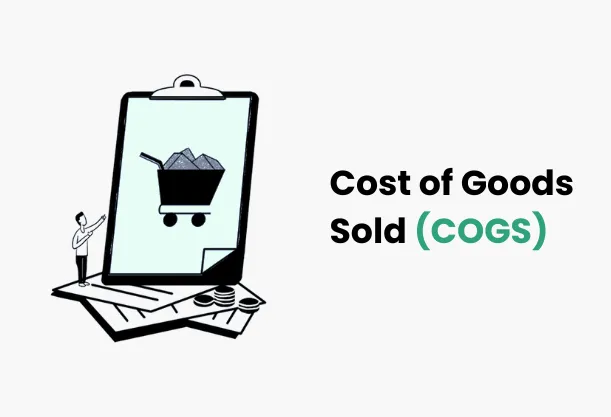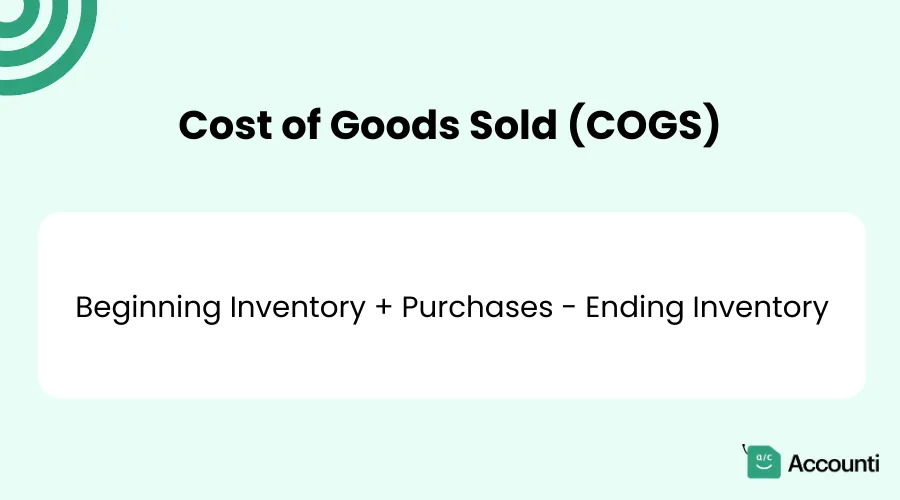
How to Calculate Cost of Goods Sold: Formula & Examples Explained
Running a business means keeping track of a lot of numbers, but one of the most important ones is your Cost of Goods Sold, or COGS. So, what is COGS, and why does it matter?
Simply put, Cost of Goods Sold refers to the direct costs involved in producing the products you sell. It’s the number that helps you figure out how much money you’re really making after covering those basic production expenses. Whether you're setting prices, planning production, or analyzing your profits, understanding your COGS is essential.
In this guide, we'll break down what goes into COGS, how you can calculate it, and why it’s a key factor in keeping your business financially healthy. Whether you’re just starting out or have been in the game for a while, knowing how to work with COGS will give you an edge when it comes to making smart financial decisions.
What is Cost of Goods Sold?
Cost of Goods Sold (COGS) is the direct cost of producing the goods sold by a company. It includes the cost of the materials and labor directly used to create the good. It excludes indirect expenses such as distribution costs and sales force costs.
Components of COGS
COGS typically includes three main components:
- Materials: The raw materials or components used to create the product.
- Labor: The wages paid to workers directly involved in production.
- Overheads: Direct factory overheads such as rent for a factory building or utility costs for running production equipment.
Importance of COGS for Businesses
Understanding and accurately calculating COGS is crucial for several reasons:
- It helps determine the true profitability of a product or service.
- It's essential for setting appropriate pricing strategies.
- It's a key component in calculating gross profit and gross margin.
- It impacts tax calculations, as COGS is deductible from revenue.
Formula for Calculating Cost of Goods Sold
The standard formula for calculating COGS is:

COGS = Beginning Inventory + Purchases - Ending Inventory
Let's break down each element of this formula:
- Beginning Inventory: The value of inventory at the start of the accounting period.
- Purchases: The cost of goods bought or produced during the period.
- Ending Inventory: The value of inventory remaining at the end of the accounting period.
This formula effectively calculates the cost of the goods that were actually sold during the period by accounting for changes in inventory levels.
Step-by-Step Guide to Calculating COGS
Step 1: Calculate Beginning Inventory
Beginning inventory is the value of inventory on hand at the start of the accounting period. This figure should match the ending inventory from the previous period. You can find this value in your previous period's balance sheet or inventory management system.
Step 2: Calculate Purchases During the Period
Purchases include all costs associated with acquiring or producing goods during the accounting period. This includes:
- Cost of raw materials
- Direct labor costs
- Shipping and handling costs for incoming goods
- Any other costs directly tied to acquisition or production
Be careful not to include indirect costs like marketing expenses or administrative salaries.
Step 3: Calculate Ending Inventory
Ending inventory is the value of goods still on hand at the end of the accounting period. There are three primary methods for valuing ending inventory:
- First-In, First-Out (FIFO): Assumes that the oldest inventory items are sold first.
- Last-In, First-Out (LIFO): Assumes that the newest inventory items are sold first.
- Weighted Average: Uses an average cost for all items.
The choice of method can significantly impact your COGS calculation, so it's important to choose the most appropriate method for your business and use it consistently.
Step 4: Apply the COGS Formula
Once you have all the components, simply plug them into the formula:
COGS = Beginning Inventory + Purchases - Ending Inventory
Let's walk through an example:
- Beginning Inventory: $50,000
- Purchases: $200,000
- Ending Inventory: $30,000
COGS = $50,000 + $200,000 - $30,000 = $220,000
In this example, the Cost of Goods Sold for the period is $220,000.
Impact of COGS on Financial Statements
COGS plays a crucial role in several key financial statements and metrics:
Income Statement
On the income statement, COGS is subtracted from revenue to calculate gross profit. This makes it a key determinant of a company's profitability.
Gross Profit and Gross Margin
Gross profit is calculated as Revenue - COGS. Gross margin, expressed as a percentage, is (Revenue - COGS) / Revenue. These metrics are essential for understanding a company's efficiency in production and pricing power.
Net Income and Taxes
Since COGS is deducted from revenue to calculate taxable income, it directly impacts a company's tax liability. Accurate COGS calculation is therefore crucial for tax compliance and optimization.
COGS vs. Operating Expenses: What's the Difference?
While both COGS and operating expenses are costs incurred by a business, they are fundamentally different:
COGS
- Directly related to the production of goods sold
- Examples: raw materials, direct labor, factory overhead
Operating Expenses
- Not directly tied to production
- Examples: rent for office space, salaries for administrative staff, marketing costs
This distinction is crucial for financial analysis as it allows businesses to separate production efficiency (reflected in COGS and gross margin) from operational efficiency (reflected in operating expenses and operating margin).
Common Mistakes to Avoid When Calculating COGS
Accurate COGS calculation is vital, but it's easy to make mistakes. Here are some common pitfalls to avoid:
- Overlooking direct costs: Ensure all direct costs are included, even small ones.
- Incorrectly calculating inventory: Use consistent and appropriate inventory valuation methods.
- Misclassifying expenses: Be clear on what constitutes COGS vs. operating expenses.
- Inconsistent accounting methods: Stick to one method of accounting and inventory valuation.
- Failing to account for returns or allowances: These can affect your COGS and should be properly recorded.
Tips for Accurate COGS Calculation
To ensure your COGS calculations are as accurate as possible:
- Regularly update inventory records: Conduct frequent physical inventory counts.
- Use inventory management software: This can automate much of the process and reduce errors.
- Cross-check with accounting records: Ensure your COGS calculations align with other financial statements.
- Maintain detailed records: Keep thorough documentation of all costs related to COGS.
- Consult with professionals: When in doubt, seek advice from accountants or financial advisors.
Tools and Software for Calculating COGS
Several tools can help streamline your COGS calculations:
- QuickBooks: Offers robust inventory tracking and COGS calculation features.
- Xero: Provides real-time inventory tracking and reporting.
- Zoho Inventory: Offers advanced inventory management and COGS tracking.
- Fishbowl: Specializes in inventory management for manufacturing and warehouse environments.
When choosing a tool, look for features like:
- Real-time inventory tracking
- Multiple inventory valuation methods
- Integration with other accounting and e-commerce platforms
- Customizable reporting
Conclusion
Calculating Cost of Goods Sold is a fundamental skill for any business owner or financial professional. It's not just about following a formula—it's about understanding the true costs of your products and using that knowledge to make informed business decisions.
By mastering COGS calculation, you gain insights into your business's efficiency, profitability, and overall financial health. This knowledge empowers you to optimize your operations, set competitive prices, and ultimately drive your business towards greater success.
Remember, accuracy is key in COGS calculation. Take the time to understand your costs, maintain detailed records, and leverage appropriate tools and software. With practice and attention to detail, you'll be well-equipped to navigate the financial landscape of your business with confidence.
FAQs
What is included in the cost of goods sold?
Cost of Goods Sold (COGS) includes all direct costs associated with the production of goods sold by a company during a specific period. This typically covers the cost of raw materials, labor costs directly involved in the production, and any overhead costs that are directly tied to manufacturing. For example, if you run a bakery, COGS would include the cost of flour, eggs, and butter, as well as wages for the bakers. However, it would not include general business expenses like rent or utilities.
What is the formula for calculating cost of goods sold?
The standard formula for calculating Cost of Goods Sold (COGS) is:
COGS = Beginning Inventory + Purchases − Ending Inventory
- Beginning Inventory: The value of the inventory at the start of the period.
- Purchases: The total cost of additional inventory or raw materials bought during the period.
- Ending Inventory: The value of the inventory remaining at the end of the period.
This formula gives you the total cost of goods that were sold during the specified timeframe.
How to calculate COGS in Excel?
Calculating COGS in Excel is straightforward using the formula:
- Create columns for Beginning Inventory, Purchases, and Ending Inventory.
- Enter your values for each column in the respective rows.
- Use the formula =Beginning Inventory + Purchases - Ending Inventory in a new cell to calculate COGS.
For example, if Beginning Inventory is in cell A2, Purchases in cell B2, and Ending Inventory in cell C2, your COGS formula would look like this:
=A2 + B2 - C2.
This will give you the Cost of Goods Sold for that period in Excel.
How to calculate COGS without inventory?
Calculating COGS without inventory is challenging because inventory values are a crucial part of the formula. However, if you don't track inventory but still need to estimate COGS, you can use the formula:
COGS = Sales × (1 − Gross Profit Margin)
- Sales: Total revenue from goods sold.
- Gross Profit Margin: The percentage of revenue remaining after covering the direct costs of production.
For example, if your sales are $100,000 and your gross profit margin is 40%, your COGS would be:
COGS = 100,000 × (1 − 0.40) = 60,000
This method provides an estimate but may not be as accurate as including inventory in the calculation.
How to calculate percentage of cost of goods sold?
The percentage of Cost of Goods Sold (COGS) relative to sales is calculated as follows:
COGS Percentage = ( COGS / Total Sales ) × 100
- Determine your total COGS.
- Find your total sales revenue for the same period.
- Divide COGS by total sales and multiply by 100 to get the percentage.
For example, if your COGS is $50,000 and your total sales are $200,000, the calculation would be:
COGS Percentage = (50,000 / 200,000) × 100 = 25%
This means that 25% of your sales revenue goes towards covering the cost of producing the goods sold.

 Rohit Kapoor
Rohit Kapoor

